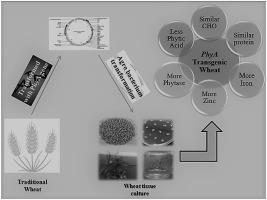Biochemical and morphological risk assessment of transgenic wheat with enhanced iron and zinc bioaccessibility |
| |
| Affiliation: | 1. Department of Food Science and Agricultural Chemistry, McGill University, Canada;2. Department of Natural Resource Sciences, McGill University, Canada;3. School of Human Nutrition, McGill University, Canada;1. Department of Analytical Chemistry and Organic Chemistry, Universitat Rovira i Virgili, Tarragona, Catalonia, Spain;2. Division of Aquaculture and Upgrading (DivAV), Portuguese Institute for the Sea and Atmosphere (IPMA, I.P), Lisbon, Portugal;3. Laboratory of Toxicology and Environmental Health, School of Medicine, IISPV, Universitat Rovira i Virgili, Reus, Catalonia, Spain;1. School of Agriculture and Food, Faculty of Veterinary and Agricultural Sciences, The University of Melbourne, Parkville, VIC 3010, Australia;2. Department of Infrastructure Engineering, Faculty of Engineering, The University of Melbourne, Parkville, VIC 3010, Australia;1. Protein Chemistry and Technology Department, CSIR-Central Food Technological Research Institute, Mysuru, India;2. Department of Food Science and Technology, Sambalpur University, Sambalpur, Odisha, India |
| |
| Abstract: | 
Decreased iron and zinc bioaccessibility, caused by the anti-nutrient phytic acid, is one of the leading reasons for micronutrient deficiency-related disorders. Biofortification of wheat with phytase gene to enhance iron and zinc bioaccessibility appears to be a fitting solution for this problem, especially in developing countries where most of the population belongs to the lower economic sector. However, societal views on crops, particularly crops that are genetically modified (GM) to express a new trait, needs to be changed. Risk assessment of GM crops can play a crucial role in fostering positive public perception, since it is imperative to ensure safety before allowing human consumption. The present study performed compositional and morphological risk assessment of T3 and T4 generations of phytase transgenic wheat by comparing their biochemical and morphological traits. Transgenic plants were analysed for their carbohydrate, protein, starch and phytic acid content along with iron bioaccessibility, zinc bioaccessibility and phytase enzyme activity. Morphological traits studied included plant height, seed number, seed weight and spike number. No significant differences were observed for carbohydrate, protein, starch content and for morphological traits; however, a significant increase was observed in phytase activity as well as iron and zinc bioaccessibility, which correlated with a significant decrease in phytic acid. These results demonstrate that phytase transgenic wheat is as native as local wheat varieties and can potentially increase iron and zinc bioaccessibility. |
| |
| Keywords: | Hidden hunger Phytase Risk assessment Iron and zinc bioaccessibility |
| 本文献已被 ScienceDirect 等数据库收录! |
|

